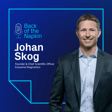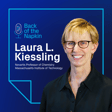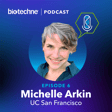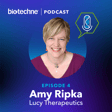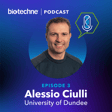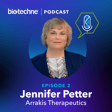Become a Creator today!Start creating today - Share your story with the world!
Start for free
00:00:00
00:00:01

Neal Devaraj: Blurring the Lines Between Chemistry and Biology
Neal Devaraj is a Professor and Chair at the University of California San Diego. In this episode, Neal talks about the innovations he has pioneered that are advancing the field of bioorthogonal chemistry. We discuss Neal’s work synthesizing completely artificial cells, designing new tools for labeling RNA, and his contribution to “click chemistry” by developing tetrazine ligation for use in live-cell imaging.
Transcript
Introduction and Discovery Methods
00:00:03
Speaker
A discovery is said to be an accident meeting a prepared mind, but every story behind a discovery is different.
00:00:11
Speaker
Perhaps the idea is conceived in a light-bulb moment, or a brainstorming session, or captured in scribblings on the back of a napkin.
Host and Sponsor Introduction
00:00:19
Speaker
Here, we introduce you to scientific pioneers, taking you beyond their publication, and into Innovation Corner to hear the untold stories behind their discoveries. This podcast is brought to you by Biotech, and I'm your host, Alex Maloney.
Neil Devaraj's Interdisciplinary Research
00:00:37
Speaker
Our guest today is Neil Devaraj. Neil is professor of chemistry and biochemistry at the University of California, San Diego, where he leads an interdisciplinary research group. We're asking some pretty big questions and providing some equally big answers that blurs the lines between chemistry and biology, when Nobel Prize winners like Carolyn Batosi describe you as a singularity in chemical biology.
Advancements in Bio-orthogonal Chemistry
00:01:03
Speaker
You know that Neil's someone to keep an eye on if you don't want to miss the next big discovery.
00:01:07
Speaker
Neil has been pivotal in advancing the field of bio-orthogonal chemistry or clique chemistry, a term some listeners may be more familiar with. For anyone not familiar, this is broadly a set of chemical reactions that allows you to attach anything to, well anything, without any side reactions in biology.
00:01:27
Speaker
Neil was an early adopter of this concept of developing reactions that could proceed at phenomenal rates in living systems, opening doors to new applications in diagnostics, fluorescence imaging and even in the therapeutic space.
Challenging Norms in Chemistry
00:01:41
Speaker
We'll leave some more info in the show notes for those of you who are inspired to read a little more about this.
00:01:46
Speaker
I was captivated by the journey Neil describes in this podcast. It's a story where he's not been afraid to step outside of his comfort zone, listening closely to the advice given by some of science's biggest names, and then applied his mindset to challenging preconceived notions around where chemistry can actually be performed.
00:02:05
Speaker
Whether it's synthetic biology and redefining what we may actually class as living or expanding the toolbox of compounds for studying RNA, Neil is absolutely making his mark in the textbooks.
Fun Segment on Scientific Discoveries
00:02:16
Speaker
And hey, we had some fun in this recording too. Make sure you stick around to the end when we play a guessing game regarding some funny scientific discoveries. But now, welcome to Back of the Knack.
00:02:32
Speaker
Neil, welcome to the podcast. Fantastic to have you on. I've been a long time fan of your research, so having you here in person to talk through some of your work is fantastic, so welcome. Yeah, great to be here, Alex. Cool. Okay, so let's start from the beginning then, kind of where all good stories start.
Neil's Early Fascination with Science
00:02:53
Speaker
So how did you get into science? Did you have parents that were scientists?
00:02:58
Speaker
Yeah, great question. I think just from a fairly young age, I've always been excited about science, starting I think from even my elementary school days. My parents immigrated from India to the US.
00:03:17
Speaker
My dad is a civil engineer and worked for city governments for many, many years before retiring, and my mom was a bank teller. So they weren't necessarily very driven, and I certainly didn't feel any pressure to go into the sciences.
00:03:34
Speaker
But I was always very fascinated, I think, with the natural world. In fact, when I was a very young child, and I'm kind of surprised my parents allowed me to do this and explore this, but I was really fascinated with insects and spiders. And I would actually, even being seven years old, would go out and catch, you know, venomous spiders and things of that nature. Looking back on it.
00:04:00
Speaker
Sorry, I was asking what was I thinking, but I think part of it was just a real fascination with the natural world. When I was in high school, I was kind of really set on this idea of doing a career in STEM.
Choosing MIT and Academic Journey
00:04:17
Speaker
And for that reason, I was really, you know, my number one choice for university was MIT, mainly because it was such a great place to do. It is a great place to do science and engineering. And I didn't really know exactly what I wanted to go into. So where did you grow up? You were in California?
00:04:38
Speaker
Yeah, I grew up in Southern California in a town called Manhattan Beach, a place quite near the major airport there in Los Angeles. Great weather, horrible traffic. So you then went and did your undergraduate at MIT, so you go over to the East Coast.
00:04:58
Speaker
Yeah, and that's kind of a funny story because I actually accepted the admission letter without even visiting MIT. And one of the big reasons was because it was the furthest place that I got into from home. I kind of wanted to get away from Los Angeles despite the great weather. I just wanted to see something different. And Boston and Cambridge were quite different. Yeah. Yeah, OK. So you major then in chemistry?
00:05:27
Speaker
Yeah, I actually majored in chemistry initially. And then I realized that if I took a few extra classes, I could also double major in biology. And so I ended up doing that as well. And did you have a preference? At the time, my preference was squarely in chemistry.
00:05:43
Speaker
You know, I was really inspired by an organic chemistry class I took with Dan Kemp. And, you know, I did undergraduate research with Munji Boendi on quantum dots.
00:05:57
Speaker
It was really a fantastic time and really encouraged me to die deeper into chemistry and to pursue a PhD in chemistry. So you then go on to do your PhD in chemistry. So where did you go then? Where was that?
00:06:14
Speaker
So I was at Stanford University. So again, I went there, not necessarily with any real goal in mind. I wasn't too sure who I was going to work with or what I was going to work on.
Pursuing PhD at Stanford
00:06:27
Speaker
But during my visit weekends, I enjoyed visiting Stanford. I think after spending four years in the Boston area, I was kind of excited to go back to California. And so yeah, I moved then to Palo Alto.
00:06:42
Speaker
Okay, so you're doing your PhD then in chemistry with, is it Christopher Chidsey? Jim Coleman and Christopher Chidsey. Okay. So actually I was fortunate to have two mentors. And yeah, it's an interesting story how that came about because I actually wrote in my application letter to Stanford that I was interested in working with a perhaps a assistant faculty member to really maybe help someone get their lab off the ground.
00:07:13
Speaker
And I proceeded then to join the lab of the oldest active faculty member in the department at the time, Jim Colbin. And it was just because one of the things that they asked you to do at Stanford was meet with various faculty and chat with them about their research projects. And I just had a really great conversation with both Jim and Chris about their research interests.
00:07:43
Speaker
I sort of really envisioned myself being able to work on these projects and learn a lot. And it was a really fantastic time.
00:07:51
Speaker
So I had a look at some of your earlier publications. I saw you started doing some of this quick chemistry then during your PhD. Yeah, soon after the concept came out, we were very early adopters. And that's really because one of the real pioneers in terms of these copper-catalyzed cycloadditions, Barry Sharpless, was Jim Coleman's post-doc.
00:08:21
Speaker
many years ago. In fact, Jim Coleman at one point in his lab had both Barry Sharpless and Robert Grubbs as postdocs. They would both go on to later win Nobel Prizes. So Jim was very well aware of the clique chemistry concept.
00:08:37
Speaker
at a time when many people weren't aware of it. And believe it or not, at a time when there was a lot of skepticism about whether this would be valuable or well utilized. Of course, nowadays, I think no one would ever argue that. But at the time, there was some resistance. But for our
00:09:00
Speaker
application which is trying to modify electric surfaces and surface chemistry can be notoriously challenging. We were attracted to using these click reactions and they worked extremely well.
00:09:15
Speaker
Okay, so you finish your, you get your PhD from Stanford, and then the next chapter in the book is heading to Harvard for a post-doc in Ralph Waze-Lader's lab.
Research in Ralph Waze-Lader's Lab
00:09:29
Speaker
So this isn't a chemistry lab now, right? You've completely kind of
00:09:34
Speaker
In the medical school, Massachusetts General Hospital, Ralph is an interventional radiologist. So that's a very interesting story and it was a time that was challenging because what happened was my graduate work was electrochemistry, surface modifications, and we were working with Click Chemistry
00:09:59
Speaker
And so, it was very exciting to start thinking about utilizing click reactions, bi-orthogonal reactions in living systems and ultimately in a translational setting in humans. And all of this was obviously inspired by the work of Carolyn Bertozzi.
00:10:19
Speaker
And so as a PhD student, I was interested in trying to do this, but again, I had no real background in the biology. And so I remember applying to various labs and either not hearing anything or being told no, that they didn't have room.
00:10:38
Speaker
And what was really kind of a pivotal event was I was able to meet with Carolyn Bertosi actually and chat with her during a visit to Stanford or the time she was at UC Berkeley.
00:10:52
Speaker
And I kind of expressed my interest to Carolyn. And Carolyn really knew who in the community was interested in this area, these topics, and who also, I think, had the bandwidth to take on some chemists. And she recommended that I contact Ralph Weisletter. And I contacted Ralph and pretty much almost immediately was offered a postdoctoral position. And I went to Ralph's lab, again, with a real goal
00:11:21
Speaker
to really just take a deep dive into the translational area. You go to a medical school, go to a hospital even, and think about how can chemistry be used to have an impact in a more translational setting.
00:11:37
Speaker
Sure. Okay. So this would have been 2007, right, that you go. And Carolyn had published that you could do this by orthogonal chemistry with the Potosi-Staudinger ligation in animals. So was this kind of, I see kind of the first
00:11:58
Speaker
publication when you're at Harvard was development of this kind of tetrazine for live cell applications. Was this kind of inspired by that work then?
00:12:08
Speaker
Oh, absolutely. And also, I distinctly remember when Carolyn came to Stanford and I met with her, she was discussing the now seminal work where they used azide cyclo-octane chemistry to label glycans and zebrafish. So definitely, yes, this was really the inspiration and with the thinking that, okay, can we do reactions now in humans?
00:12:35
Speaker
And, you know, what I think eventually led to the tetrazine chemistry was sort of the realization that, you know, Ralph, one of his real key areas of strength, right, is in imaging, molecular imaging, radiology. In fact, he's an interventional radiologist. And so we were thinking about ways in which we can apply
00:13:00
Speaker
biorthogonal chemistries, if you will, to imaging agents. And oftentimes, imaging agents are at very low concentration. So we start thinking about, okay, just back of the envelope, what kind of kinetics, what kind of rates of reaction do you need to get very, very low concentrations of molecules to react with each other and have the reactions complete with reasonable efficiency. And we quickly realized that
00:13:24
Speaker
you really have to have very high rate constants. Ideally, thousands or higher per molar per second to get really good efficiencies if you want to work with micromolar or lower concentrations of reagents.
Inspiration from Carolyn Bertozzi
00:13:37
Speaker
And that caused us to start thinking about, OK, what other kinds of chemistries, particularly cycloadditions, could be utilized that would be catalyst free, that would occur spontaneously. They could also potentially occur very rapidly. And that's what drew our attention to the tetrazine cycloaddition, which there had been this large body of work done in physical organic chemistry, looking at the rates of reactions between tetrazines and
00:14:05
Speaker
olefins, dienophiles, particularly strained dienophiles like trancycloactines, cyclopropines, norbornines, and then that sort of led us into that area.
00:14:17
Speaker
Okay, so you spend then your time doing your postdoc at Harvard and get to 2011 and you move to UCSD, so to be an associate professor, so how did? Assistant professor.
00:14:37
Speaker
So how did that kind of happen? Did you want to, because obviously now you're going back to the west coast, was there kind of some tighter there? Did you feel like you were far away from home?
00:14:48
Speaker
Yeah, I think so. It's an interesting process when you're looking for your independent positions. You send out massive number of applications and you get interviews at a handful of places. I was fortunate to get interviews and offers at a few different places.
00:15:08
Speaker
Growing up in Southern California and then visiting UC San Diego, it was a very, very attractive location, particularly for the kind of work that I wanted to be doing in chemical biology. And also this sort of, eventually it will become a major part of our lab is this interface between chemistry and biology and living and non-living systems. And so UC San Diego, in addition to being just a fantastic place to live, I mean San Diego is an amazing
00:15:36
Speaker
area at the time you had these real excellent research groups like Roger Chen's lab who had pioneered the development of tools and imaging agents for biology. And so that was really one of the great things about stepping into UC San Diego is you never had to explain to people, okay, why is it important as a chemist to develop tools for biology?
00:16:03
Speaker
Roger Chen was there. No one needed that explanation. This is a valuable thing to work on.
00:16:09
Speaker
And additionally, historically, from eventually the work that our lab started doing at asking questions about, for example, artificial membranes, synthetic cells, origin of life, one of the real founding faculty at UC San Diego, Stanley Miller, from the famous Miller experiment, looking at sort of the origin of life. And so again, there was a sort of this really interesting history there that supported the research proposals that I wanted to work on.
00:16:38
Speaker
Okay, so let's go into some of these research areas of interest then. We've discussed a bit already about these tetrazine cycle additions. But as you touch on there, a huge thrust of your work is looking at these artificial membranes. And this is completely out of my wheelhouse, but having read it, it's really kind of blowing my mind what seems to be possible now. So can you tell us a little bit about the work you're doing here with these synthetic cells?
Chemistry Meets Biology: Synthetic Cells
00:17:06
Speaker
Yeah, so I mean, I think this just it stems from a just a genuine fascination interest with
00:17:15
Speaker
this sort of, I think, gap in our knowledge in biology, which is we know quite a bit, I think, about the structure and function of the various molecules of life themselves, DNA, proteins, lipids. But then how these things come together to form what we would say is living matter. This is, in many ways, still a virtual black box. And so I think there's a lot of really interesting science there. And as a chemist, I think this is fascinating. How does chemistry become biology is a really fascinating question.
00:17:44
Speaker
And so back now to my PhD days, we had done a lot of work with self-assembly and looking at self-assembled model layers. And I was always very fascinated with self-assembly concepts. And so when I started to think about, well, how can we as a lab do something to start approaching this really, really challenging big question in science?
00:18:10
Speaker
We got really interested in the idea of well, could you start generating compartments and lipid membranes and and as a chemist I mean one of the really fascinating things I think about life and cells is that not only is our amazing self-assembly occurring but the cells are actually in situ producing.
00:18:26
Speaker
the units that are self-assembling in real time, you know, they're the same time simultaneously to the self-assembly itself. And so we started thinking about ways in which we could use chemistry to spontaneously generate lipids, you know, de novo, that would then go on to immediately self-assemble and form membranes. All of this happening in water. So I wrote down the, I think a key publication here from you, which was self-reproducing catalysts that drives repeated phospholipid synthesis and membrane growth.
00:19:04
Speaker
you've pioneered some work around the tetrazine ligation, which allows you to do this in kind of live cells. Now you're looking at kind of creating a new kind of cell. And the whole reason, you know, well, one of the reasons for using tetrazine is, you know, you don't use copper, which is toxic to cells. Now you're looking at creating cells that actually need copper, right? So that's, I find that kind of fascinating. Yeah. I mean, I think you can start, you know, cells and biology, right? One of the key, um, uh, uh,
00:19:18
Speaker
But reading into this, it was fascinating.
00:19:33
Speaker
components that make it all work are the idea of having catalysts and enzymes.
Autocatalysts and Synthetic Cell Growth
00:19:37
Speaker
And so you can view copper in that case as a very, very simple primitive catalyst, if you will. And I think what is interesting about that work and something that we still think about quite a bit is the idea that can you take an autocatalyst that is a catalyst that can make itself over and over again
00:19:58
Speaker
and couple that to the formation of other functional building blocks that would be useful for a synthetic cell, like lipids to form a compartment. And in theory, if you start feeding those systems very simple precursors, it could basically go on and on, grow, regenerate over and over and over again, because not only are the lipids being made continuously, but also the catalyst is able to make itself continuously.
00:20:24
Speaker
And so I think that's a really kind of interesting concept and something that to this day we're still thinking about ways in which we can achieve that in the lab and eventually do it in a much more complex way, which is, you know, of course, living systems are extraordinarily complex and also get, you know, over time, over evolution, they appear to get more complex.
00:20:46
Speaker
So what's the next stage then? You've got cells that are able to kind of reproduce. Now what do you kind of put in them? Do we need to have, you know, synthetic organelles? Do we need, yeah, what's next? Yeah, that's a great question.
00:21:01
Speaker
The big next thing is transport systems. So how can, if the cells need these simple metabolites to keep on growing and dividing, how do they get those to come in? And again, they spontaneously generate systems that would allow it to become even more efficient in terms.
00:21:19
Speaker
One of the hallmarks of life is the idea of Darwinian evolution and competition. You can imagine if one synthetic cell has a more sophisticated transport system, it can grow and divide at the expense of others. Another element is asking how could you have information and information transfer.
00:21:43
Speaker
heredity, if you will. And when we think about that, we obviously immediately jump to DNA, RNA, things about nucleic acids. But it's also kind of interesting to start thinking about, is that really the only way? Are there other ways you could have information that would be memorable, if you will, to these systems? And so one of the things we've thought about, and others have thought about quite a bit, is the idea that it could lipids in the compositions themselves.
00:22:10
Speaker
have some kind of information inherent to them. And can you show that experimentally is a real challenge, but I think it's an interesting thing to think about. Yeah, I can't even get my mind around that, but yeah, I really look forward to seeing what happens there. But this idea you say of kind of like evolution and being able to create a synthetic cell that's capable of evolving. I've got this kind of really crazy idea in my mind that you could have this cell,
00:22:38
Speaker
just stick it on a rocket to Mars or whatever it goes up there, it's capable of then evolving from selection pressures and then, I don't know, we come back in a few billion years and we see what's happening. Well, I think one of the big challenges there is, and it's a great thought experiment, but then you have to say, well, okay, but that cell then has to be able to take inputs or resources that would be present on Mars.
00:23:01
Speaker
So now, I think the current state of the art in the field is many folks. In fact, I just, as you know, was at a really fantastic Royal Society meeting on essentially synthetic artificial cells. And a lot of us are working in this area and the inputs tend to be still pretty complex.
00:23:22
Speaker
So example, the paper you just mentioned, the inputs were still these synthesized lipids. These aren't things you would just find naturally laying around. So if you shot that cell into Mars or wherever, it's not really going to do anything because it needs a chemist sitting there and synthesizing these things and feeding them.
00:23:43
Speaker
You know, aspirational goals, if you will, is to start building synthetic cells where you could take really simple precursors. I mean, ideally, you know, light and carbon dioxide and you have generation of, you know, building blocks. Yeah. Yeah. Okay. And that was going to be kind of my next question really was how could you create these synthetic cells for something useful? Like what is the, what is the end goal here?
Fascination with Fundamental Science
00:24:08
Speaker
If there is one?
00:24:10
Speaker
Yeah, I think, you know, for me personally, when I got into the area was not necessarily to try to create something useful, I always believe that there would be something useful. But whether that would be in five years, 10 years, 20 years, as not clear, but more immediately is sort of the fascination with the basic
00:24:28
Speaker
science and the sort of very, very fundamental chemical biological questions. But that being said, I think it's becoming increasingly clear that there are going to be uses and in fact, there might be happening right now. I think one area that is really exciting and obviously has had a huge application is lipid nanoparticles. And so you start thinking about what these lipid nanoparticles are, well, you know, they contain
00:24:55
Speaker
They have lipids, they have nucleic acids. You start thinking, well, they kind of start, you could call them sort of a synthetic virus, if you will, or they have sort of analogy to some of the kinds of systems that people are developing in the synthetic cell community. So I think one, I think, application that's on the horizon would be, I think, for delivery purposes. So thinking about these synthetic cells as interesting ways to deliver biological payloads could be something that would be really interesting to develop.
00:25:24
Speaker
Yeah, yeah, and maybe we can use that as a segue then talking about lipid nanoparticles and delivery of kind of RNA to your work in the RNA space then.
Developing RNA Bioconjugation Tools
00:25:32
Speaker
So now kind of completely changing to a sort of a different area is work that you're doing. And I've kind of highlighted one of the key publications here, which was
00:25:45
Speaker
Yeah, this site-specific covalent labeling of RNA by enzymatic transglycosylation. So this is obviously where... Kind of a mouthful when you hear it read back to you, but yes. This is where Ampass obviously initially crossed when we met last year in San Diego and an area I find hugely interesting as well. So maybe you could give us a bit of a description and background into this.
00:26:10
Speaker
Yeah, so you already sort of discussed how I started my lab at UC San Diego, and we were already very interested in general in bioconjugation chemistry, having worked on tetrazine chemistry, having worked in clique chemistry, having thinking about interesting ways to connect biomolecules together.
00:26:32
Speaker
In addition to UC San Diego having this really great history in origin of life and green forest and protein, it also has a really core strength in RNA biochemistry. At the time, I'd never really even worked at all with RNA. I've got to do this, yes. But I was actually my neighbor.
00:26:55
Speaker
your location and your surroundings and really influenced your science and the research. And so where my lab was at the time, my neighbor is a professor in biochemistry, Simpson Joseph had a strong interest in RNA biochemistry and basically just kind of encouraged me to start thinking about as a bioconjugation chemist, why don't you think about developing new tools for manipulating and modifying RNA?
00:27:26
Speaker
And so I thought that was quite interesting. And I was following work in the RNA field, particularly because many of my colleagues were studying RNA. And looking at many of the tools that were out there to modify and manipulate RNA, and there were fantastic things, molecular beacons, aptamer systems, RNA binding proteins. But as a chemist, I feel like someone that had been working in
00:27:56
Speaker
various types of ligation chemistries, one thing that struck me is that there weren't
00:28:04
Speaker
And so we started thinking, and again, this seems kind of naive, but we just sort of thought, well, without even really thinking too much about it, what would an ideal RNA labeling system look like? So we started thinking, well, we'd want it to be a covalent linkage, a minimal modification, be able to recognize a minimal structure of the RNA as a recognition element so you didn't have to append a huge large RNA thing onto your RNA of interest.
00:28:33
Speaker
You want to be very flexible, you want to be able to label not just fluorophores for imaging, but maybe biotin for affinity labeling, other peptides perhaps, so you don't really want to be locked into one type of thing.
00:28:50
Speaker
And so, yeah, we just started thinking about that and it took time and we had more and more discussions with folks and, you know, again, being surrounded by my colleagues that knew a lot about RNA.
00:29:06
Speaker
The suggestion was, why don't you look at what nature does with post-transcriptional modifications, particularly with tRNA. So this was completely new to me at the time, but I started reading into it and I realized that, wow, yeah, tRNA is very heavily post-transcriptionally modified. And as such, there's a huge array of enzymes in nature that can modify tRNA covalently.
00:29:29
Speaker
And so I started looking through these enzymes and started thinking, well, would it be neat? It would be kind of neat if we could take one of these enzymes and sort of hijack it, if you will, to label an RNA of interest covalently with a real functional unit, like a fluorophore.
00:29:44
Speaker
And of all the sort of modifications that are out there, one class of modifications really stood out to us. And those are these transglycosylases, these tRNA transglycosylase. And these really, really fascinating class of enzymes. And that's kind of what led to this work that you were talking about.
00:30:03
Speaker
Yeah, and it's been fantastic to see some of the applications that you have now applied this to. I mean, the paper recently this year on applying it to the CRISPR-Cas9 system, I think is a fantastic example of how this can be
Using RNA Transglycosylases
00:30:20
Speaker
used. And I'm really keen to see how else this gets used.
00:30:27
Speaker
Yeah, I mean what's kind of interesting about that story is that when we initially start thinking about using these transglycosylases, which normally what they do is they essentially remove a guanine, they break the glycosidic linkage in the RNA, they switch that base for another base, and the bacterial versions of these enzymes switch it for a bacterial metabolite called pre-Q1.
00:30:56
Speaker
And so initially, our thinking was, well, let's make analogs of pre-Q1. And then, well, perhaps we're going to have to evolve or modify or manipulate the enzyme so we can accept these analogs. And to our delight, it turned out that you didn't have to modify the enzyme at all. The enzyme's promiscuous enough. And if you design your pre-Q1 analog correctly, it can actually just accept it directly. And so you can take now, our initial work showed things like fluorophores and biotin.
00:31:24
Speaker
could be directly accepted by the enzyme and covalently attached to your RNA of interest if you append a short recognition element. As small as could be 17 nucleotides.
00:31:37
Speaker
But over the years, and I've been asked this question a lot of times, what's the limitation? How big of a thing can you append? And honestly, we really have not done a good systematic job of looking at that. In fact, it actually kind of remains to be seen. Quite a few different things we've worked with have all been appendable, if you will.
00:31:56
Speaker
So I think that's something actually we're starting to think about looking at a little more systematically now. If you take large polymers, for example, of different molecular weights, at what point does the enzyme stop working or does it stop working?
00:32:09
Speaker
Sky's the limit, right? Yeah, I kind of view it nowadays like RNA glue. I mean, you know, you can put whatever you sort of want now covalent onto an RNA of interest. And I think that really is exciting, particularly for the new folks that joined the lab and start working on this project is you can really kind of let your imagination go wild a little bit and dream up all sorts of interesting sort of applications and ideas.
00:32:35
Speaker
Okay, so that kind of, this podcast, Neil, it's called, we call it Back of the Napkin. The idea being that when you come up with ideas and inventions, it can sometimes be in a place where you're close to a napkin and that's the easiest thing to sort of scribble down your idea on and capture it on. But it can be a metaphor as well. So I'm interested to hear,
00:32:57
Speaker
you've come up with some fantastic discoveries like how do you and you've talked already through how you kind of systematically put some of these ideas together but when you're sort of sitting there and kind of thinking how are you doing that are you sitting there with kind of your group is it kind of
00:33:11
Speaker
It's something that just kind of pops into your head. What's your thought
Creative Process and Inspirations
00:33:16
Speaker
process? What's the creativity process? That's a great question. I think it's always a little different, but I think a lot of times it starts with actually sitting in a seminar and hearing something. It could be tangential, but it can sometimes spark an idea. I really didn't think about that, and I didn't really realize that was a problem.
00:33:37
Speaker
And how could you solve a problem? A lot of times it comes with just talking with colleagues. I think that's been a recurring theme, I think, through a lot of these ideas, having really great colleagues that are accessible, that you can chat with, that often are in different disciplines or have different expertise.
00:33:55
Speaker
so that you can gain sort of windows into areas that you may not be necessarily so familiar with, which is often, for me, an issue. And one of the reasons, again, why I joined UC San Diego was I was able to join the biochemistry division. And one of the reasons I was excited about that is I hadn't really been trained as a biochemist. But I wanted to work and apply sort of the chemical tools and chemical know-how to biochemistry.
00:34:21
Speaker
So I think that's important. And then what often happens is there is this period of just thinking about the concept and idea versus doing. And so you may have an idea. I think the first thing you do is you go into literature. You try to see, OK, what's been done? What's the closest thing that's been done to this idea?
00:34:50
Speaker
And then I do often chat with group members, get their take on it. And then sometimes it can take a while. I believe with the RNA tag work, this idea of looking at these transglycosylases, I think we had this idea rattling around for almost a year.
00:35:11
Speaker
And, you know, the other thing that we often don't talk about is also making sure that, you know, you have the right people at the right time. So, you know, who wants to actually work on this idea? Who's going to be excited to work on this idea?
Influence of Carolyn Bertozzi
00:35:21
Speaker
And I was fortunate that we had a really great postdoc at the time, Seth Alexander, who had come from a lot of Shephard's lab. And, you know, he's really excited about this idea as well. And that's how it all sort of came together.
00:35:33
Speaker
Cool. Okay, so one of the next sections we've got here is scientific leaders, and you've mentioned some of these I think already, but who have been the scientific leaders who have been kind of instrumental in your career that have helped you kind of get to where you are now?
00:35:54
Speaker
So yeah, I mean, absolutely, we already chatted a little bit about her, but Carolyn Bertuzzi has been a real inspiration, and it's also been extremely supportive. One person we didn't chat about, but it's kind of related to this transition between my postdoc and my independent career is Jack Shostak at the Mass General Hospital. So I was very fortunate that
00:36:17
Speaker
He was, at the time, in fact, I think he just moved to Chicago, but he was working a couple floors above my postdoctoral lab, actually. And so the time when I started thinking about, you know, when you apply for independent positions in the US, you have to put research proposals in.
00:36:37
Speaker
And so I remember trying to develop these proposals, thinking about this interest in lipid membranes and artificial membranes. And I sent him an email, and I just figured, well, he's right there. It'd be really great to pick his brain and think about, given what he's done. And he's done really inspirational work in the field of origin of life, and looking at simple protocells, if you will, really beautiful work.
00:37:07
Speaker
showing that Procells can grow and divide. And so, yeah, I sent him an email and he was happy to meet and chat. And again, that was really a great experience and been able to see him at meetings and chat with him. And so that's been really, really nice.
00:37:26
Speaker
Yeah. I saw a, well, there was a quote from Carolyn Batosi, and she described you as a singularity in the world of chemical biology. And, you know, I can't really think of any higher praise from someone like Carolyn. Obviously, one of the winners of this year's Nobel Prizes. That's fantastic to see. So do you speak regularly with Carolyn?
00:37:53
Speaker
Yeah, at meetings and often talking about biographical chemistry and new directions. I mean, I think one of the, another sort of highlight was, and there's quite a bit of pressure I think on some level too, is, you know, Carolyn, among the many, many amazing things that she does, she also, you know,
00:38:12
Speaker
is in charge of ACS Central Science, which is a fantastic journal. And a little while ago, she asked me to write a perspective article in ACS Central Science on the future of bio-orthogonal chemistry. And it was a little bit of pressure. I'm not giving away all my secrets.
00:38:35
Speaker
No, I mean, you have the founder of the field in terms. But I think it was a really interesting experience to really sit down and think about where, from my perspective at least, from one person's opinion, where can the field go. And I think that was published a few years back. And I think it's already, I mean, the field has just gone forward so far. I think it's already become dated.
00:39:04
Speaker
Yeah, perhaps a new one needs to be written soon. I saw that you've got like the crystal ball, haven't you, with the different handles on? Yeah, I've seen this kind of circulating again.
00:39:19
Speaker
Yeah, very good. Yeah, I mean, I think one of the things that were pointed out, then this is actually another area that, you know, we were quite interested in the master in hospitals, the idea of, you know, delivering therapeutics and imaging agents using so called pre targeted approaches.
00:39:35
Speaker
with Tetrazines. And I mean, now you have companies that have raised significant amounts of money looking at this. And one of these companies in particular has taken this to clinical trials. Shaski, right? Yeah, that's amazing. And they're in phase one, two at the moment. So yeah, I was reading the CNN article on that. Yeah, fantastic to see.
00:40:00
Speaker
Okay, so challenges, no journey seems to be free of challenges or
Challenges of Interdisciplinary Work
00:40:07
Speaker
hurdles. So have there been particular challenges or hurdles in your scientific career so far that you've had to overcome?
00:40:15
Speaker
Yeah, I think we kind of touched a little bit on it. I think it can be really instrumental to work between disciplines, to jump into new areas. I think it's super, super rewarding, but it can be very challenging too because we do, I think, somewhat silo ourselves in academia.
00:40:36
Speaker
And so you know there are sort of clicks and so we start departing from those clicks and try to reenter it can be challenging and also the cultures you're trying to get exposed to these new cultures like for example the medical school is a little bit of a jarring experience very very different culturally.
00:40:57
Speaker
You know, this can be challenging, but I think it's worth it. I mean, you know, and, you know, I think my message to those who are thinking about doing it is, yeah, just to be patient. Someone told me a long time ago, actually, the late Richard Lerner told me this a long time ago, he said, you know, at the time, I was very young, and I was very, you know,
00:41:22
Speaker
just had been doing chemistry and thinking, okay, you know, I want to jump into this new area. I want to do translational work, you know, like I can do this, right? And he was always telling me, well, he often thinks it's good if you pick something that's sort of tangentially related to what you're already working on and slowly move into this new field. And, you know, I think looking back on it, and that's kind of sort of what I did. And I think that's not bad advice.
Fun Segment: Ig Nobel Prize
00:41:49
Speaker
Okay, so we're kind of coming towards the end of the podcast, but for something different, we've got a something fun to finish feature here, which is a little kind of guessing game centered around the Ig Nobel Prize. Are you familiar with that? The Ig? Yes. Remind me again exactly what the Ig is for. So this is a satiric kind of award that's given to 10 studies every year for science that makes you
00:42:17
Speaker
First laugh and then think there's been some really kind of good and it's you know, it's very prestigious. It's awarded by Nobel laureates at Harvard and then I think they go over to MIT to give a lecture. So the premise of this game is
00:42:34
Speaker
I have got two studies here. One of them formed the basis of an Ig Nobel Prize and another one didn't. So you have to guess which one of the recipients of the award. And you'll have to give us your workings as well as to kind of how you get to your answer. So number one then was a study that looked at the effect of having Christmas dinner with the in-laws on the gut microbiome composition.
00:43:00
Speaker
So that's number one. And the second one is a study looking at the scientific validity of the five-second rule. And this is, of course, the universal rule for if you pick food up off the floor and eat it after five seconds, you'll die. So one of these has been awarded the Ignoble Prize. And we'll kind of go into a little bit more about them both after, but which one do you think it is?
00:43:22
Speaker
My initial instinct is to go with the five-second rule. To me, that already sounds very interesting. Everyone who hasn't heard of the five-second rule, right? When I was younger, I was often invoked. I think it's important in science in general to have something that actually
00:43:46
Speaker
even the public can understand the importance of it. This is, like you said, a sort of a prestigious, you know, pride. So I'm kind of thinking that would probably generate a lot of interest. But that would be my guess. Okay. And you're spot on actually, that is completely correct. You know, there's pages on Wikipedia, it's kind of about a five second rule.
00:44:05
Speaker
even myth busters have looked at it. This was awarded in 2004 to Gillian Clark from the University of Illinois and actually got the Ignoble Prize in public health. Actually, the outcome was
00:44:23
Speaker
She was dropping food on public flooring and found that there seemed to be no contamination, but when dropping on a tile that was laced in E. coli, that obviously did transfer. I think we should say jury's still out and it's probably safest to just not eat any food that's fallen on the floor. Yeah, tell this to my one-year-old.
00:44:49
Speaker
Yeah, exactly. But then, yeah, so the other study as well, maybe Ignoble Prize worthy, I think, so this was some scientists who looked at the effects of having Christmas dinner with your in-laws on the microbiome composition and
00:45:05
Speaker
They show that it's negatively effective as a species of rheumococcus is decreased, which is supposedly involved in psychological stress and depression. I have a feeling these scientists just wanted to get out of their Christmas dinner.
Contact Information for Neil Devaraj
00:45:25
Speaker
Lastly then, Neil, before we sign off, how can people get in touch with you if they want to reach out?
00:45:33
Speaker
I can Google my name and I have an email address at UC San Diego and I'm happy to receive emails. Awesome. We can include anything that we've discussed in the show notes of this. That's great. You don't have Twitter? Is that all right? No, but I have my email and I'm happy to always, as many people constantly online and checking.
00:46:02
Speaker
As you know, this podcast is called Back of the Napkin and we ask every guest to come on to leave us a little message that's personal to their scientific journey. Before you leave at some point today, I'm going to get you to leave your message and keep that in the archives of guests who have been on the show. Sounds good. Thanks so much for being on, Neil. It's a pleasure to have you here. Yeah, thanks for having me. Thank you.
00:46:33
Speaker
Thanks for listening to this episode, Back of the Napkin. To hear more stories of innovation and discovery just like this, subscribe to Back of the Napkin on Apple Podcasts, Spotify, Stitcher, or wherever you get your podcasts from. If you enjoyed this episode, please consider sharing it with your friends, colleagues, or lab mates. Back of the Napkin is made possible by Biotechnique.
00:46:58
Speaker
where science intersects innovation. Biotechnique is a supply of high quality and innovative tools for life science research, therapeutic manufacturing, clinical diagnostics, and more. They encompass brands like R&D Systems, Tokris Bioscience, Novus Biologicals, ProteinSimple, Advanced Cell Diagnostics,
00:47:20
Speaker
exosome diagnostics and a surgeon to name some. To learn more you can visit the website at biotechny.com that's bio-techni.com


